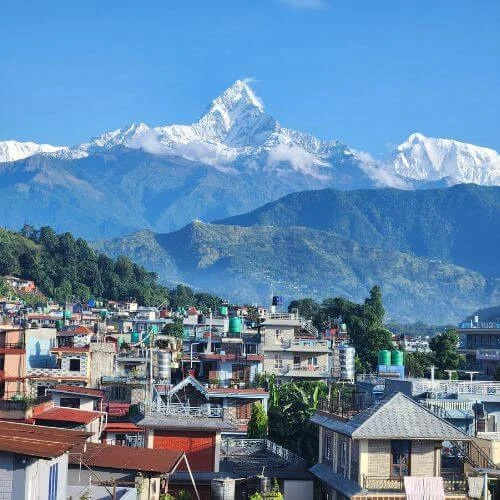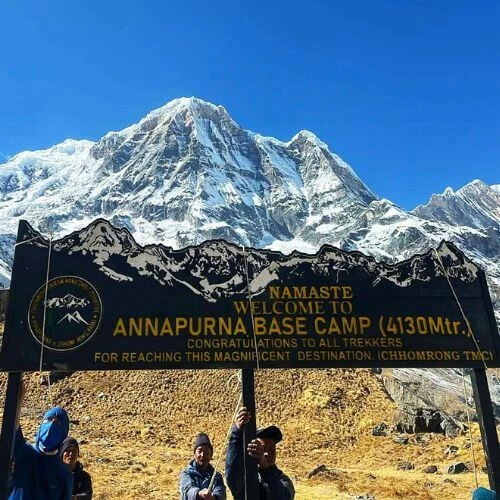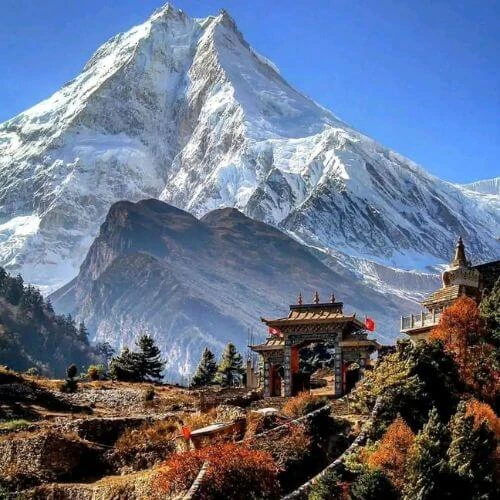Lukla Airport- Tenzing Hillary Airport- Gateway to Mount Everest
In northeastern Nepal's Solukhumbu district, the small town named Lukla sits at a high altitude of 2,860 meters above sea level and hosts one of the world's most dangerous airports, known as Lukla Airport. Despite its reputation as a dangerous airport, hundreds of people depend on it for flying in and out for trekking and expeditions in the region. This airport was renamed as Tenzing-Hillary Airport in 2008 to honor Sir. Edmund Hillary and Tenzing Norgay, the first climbers to reach the summit of Mount Everest in 1953.
Lukla Airport, the main gateway to the Everest region, held the title of the most dangerous airport in the world about 20 years ago, primarily due to its short runway, measuring just 500 meters, and the lack of advanced radar for landing assistance, along with the challenging conditions of high altitude and unpredictable weather. Situated at an altitude of 2,845 meters above sea level, on the edge of a mountain with a huge 600-meter cliff nearby, the airport presents additional challenges. Moreover, the runway isn't flat—it slopes up at a steep 12%, further complicating the landing process. All these tough challenges make Lukla Airport a scary but exciting place for travelers and pilots, full of hurdles and unexpected twists at every turn.

Even though Lukla Airport is considered a dangerous airport, it is quite safe. The airport implements significant measures to ensure everyone's safety. Firstly, pilots must possess substantial experience before attempting to land there. Additionally, if the weather deteriorates, the airport promptly closes until conditions improve. Most accidents occur due to poor visibility or rapidly changing weather conditions. However, airlines exercise caution and refrain from flying in unfavorable weather. Lukla Airport has experienced only three severe accidents, all attributed to adverse weather conditions. Given the large number of flights each day, sometimes exceeding 50, this safety record is indeed impressive. So, if you're planning to trek in the Everest region and have concerns about flying into Lukla Airport, despite its reputation, it is quite safe.
Trekking to Everest Base Camp wouldn't be complete without experiencing the thrilling flight to Lukla Airport. Despite its risks, this flight provides one of the most spectacular experiences of a lifetime. Lasting around 40 minutes, the journey presents breathtaking views of the surrounding mountains and landscapes, including the majestic Mount Everest and other towering peaks. It's an exciting adventure that heightens the thrill of your trek, leaving you amazed by the stunning natural beauty all around you.
What makes the Lukla airport the most dangerous airport in the world?
Lukla Airport is considered the most dangerous airport in the world for several reasons.
- The extreme mountainous terrain surrounding Lukla Airstrip in the Himalayas poses a significant challenge for pilots. Steeply rising mountains enclose the runway at one end, while it sharply drops off at the other, providing a minimal chance for error during takeoff and landing. Lukla is one of the shortest and steepest runways globally, measuring about 527 meters (1,729 feet) in length with a steep gradient of 12%. Additionally, there is no option for a go-around maneuver. Pilots must execute precise maneuvers to safely navigate the challenging conditions and ensure a smooth landing or takeoff within the limited space available.
- Lukla Airport, which sits at a high altitude of 2,846 meters (9,334 ft), the air thinness makes it harsh for airplane engines to work efficiently. This thin air affects plane performance because they have less air to push against. This results in more difficult takeoffs as planes struggle to get enough lift to climb safely. They require longer runways to gather enough speed. Landings also become tricky because the thinner air doesn't slow down the planes as quickly as they would at lower altitudes.

- Lukla Airport faces unpredictable and sometimes severe weather. High winds, snowstorms, and poor visibility are common, leading to frequent delays and cancellations. These weather challenges make landing and taking off even riskier for planes, adding another level of danger for pilots and passengers alike.
- Lukla Airport is renowned as one of the world's most perilous airports due to a combination of factors. Its high altitude, rugged terrain, and unpredictable weather conditions present formidable challenges for pilots and aircraft alike. Despite its dangers, Lukla Airport remains a crucial gateway for tourists heading to the Everest region, making it easier for people to reach one of the most famous destinations in the world.
Safety Standards at Lukla Airport
Despite being known as one of the world's most challenging airports, Lukla Airport has taken significant steps to enhance safety. Highly trained pilots, specialized for high-altitude landings, undergo rigorous testing and training to effectively handle Lukla's demanding conditions. Modern aircraft, equipped with powerful engines and enhanced braking systems, further ensure safe operations. Operational procedures strictly enforce visual meteorological conditions, leading to cancellations or delays if weather conditions aren't favorable. Additionally, Lukla undergoes regular inspections, maintains emergency response plans, and emphasizes the importance of smooth landings due to limited go-around options. These measures highlight Lukla's commitment to safety for travelers journeying to the Himalayas.

Interesting Facts about Lukla Airport
- In 2008, the airport received its new name, Tenzing-Hillary Airport, as a tribute to Sir Edmund Hillary and Tenzing Norgay, the pioneers who scaled Mount Everest in 1953.
- Trekkers starting their Everest Base Camp trek and other Himalayan adventures mostly commence their journey at Lukla Airport, situated in the Khumbu Pasanglhamu district of Nepal.
- The airport currently occupies its location because local farmers refused to give up their flat farmland. For $2,650, Edmund Hillary bought the land from the local Sherpas where the airport now stands.
- Lukla is considered one of the most dangerous airports in the world due to its high altitude, short runway, and lack of go-around options. However, advances in technology and pilot training have significantly enhanced safety measures.
- Flights to and from Lukla are heavily influenced by weather conditions. Strong winds, snow, and low visibility can lead to cancellations or delays. Travelers should anticipate schedule alterations and ensure they allocate extra time to their itinerary.
- The challenging terrain around Lukla makes go-around procedures impossible for pilots, which involve abandoning a landing and trying again. The pilot's skill and favorable weather conditions are crucial for a successful landing.
- The flight to Lukla Airport imposes a maximum baggage allowance of 15 kg.
- Only a Twin Otter-sized plane can land at Lukla Airport. Regular commercial flights are facilitated by companies such as Nepal Airlines, Sita Air, Summit Air, and Tara Air.

- Lukla Airport was established in 1964, but operational activities did not commence until 1971. Blacktop paving started in 2001.
- Lukla Airport relies solely on radio communication for landings and take-offs as there is no air navigation or radar system in place.
- Lukla airport has held the title of the most dangerous airport in the world according to Most Extreme Airports, a TV show on The History Channel, for over 20 years.
How to reach Lukla
Lukla, a small town in the Khumbu region of Nepal, typically serves as the starting point for all treks in the Everest region. Since there are no direct road services between Kathmandu and Lukla, reaching Lukla is usually accomplished either by foot or trekking. However, it is still possible to reach Lukla by bus if one takes a bus to Jiri or further, and then treks from there. Nevertheless, the most convenient way to reach Lukla is by air, utilizing Lukla Airport.
By air
The most popular and convenient way to reach Lukla is by air. You can simply take a flight from Kathmandu to Lukla, which lasts about 30-40 minutes. Airlines like Tara Airlines, Goma Airlines, Simrik Airlines, Sita Air, and Summit Air operate daily flights from Kathmandu to Lukla. Delays are quite common due to weather conditions in Kathmandu, Lukla, or along the route. Sometimes, flight cancellations in Lukla can disrupt the entire trip plan.
Another option is to take a helicopter, which usually takes 25 to 30 minutes, to get to Lukla. Although this option is more costly than flying, it provides a faster and more comfortable means of transportation. It also has the plus point of giving you a bird's eye perspective of the Himalayas.

Note: One should note that flights from Kathmandu to Lukla are diverted to Ramechhap Manthali Airport to reduce congestion and potential delays, ensuring a smoother flying experience during peak seasons. During these busy months, an average of 35 flights per day are scheduled for Lukla, and an average of 35 flights per day are scheduled for Lukla. Moreover, the flight from Ramechhap to Lukla is just 20 minutes of scenic flight by a small Dornier aircraft.
By bus and foot
You can trek from Kathmandu to Lukla by road and on foot, which takes about 4–6 days. It typically begins by taking a Jeep to either Jiri or Phaplu. From there you need to trek to Lukla, it takes three days from Phaplu and five days from Jiri. Few people take these trails nowadays, but those who do like the gradual journey through the Everest region. They get to see the landscape and culture change slowly along the way.
Flight Delays and cancellations
Due to unpredictable weather conditions and unforeseen circumstances, flight cancellations and delays are common at Lukla Airport. It is recommended to build in some extra days at the end of the trek and avoid scheduling an international flight immediately after completing the trek. Rapid changes in weather conditions and visibility in Lukla make it challenging to stick to regular flight schedules. Even if a flight departs from Kathmandu to Lukla, it may need to turn back due to clouds obstructing the airport's visibility. Factors contributing to flight cancellations and delays include bad weather along the route or in Lukla, high air traffic congestion during peak trekking seasons, adverse climatic factors such as high winds and low visibility (especially during winter and monsoon), and the challenging approach to the narrow runway.

If your flight to Lukla is delayed or canceled, here's what you can do: First, talk to the airline staff at the airport to get updates on the delay or cancellation. Keep an eye on the weather reports for Lukla to understand the situation better. Stay patient because delays are common; bring along entertainment like books or games to pass the time. Don't forget to check on your baggage and explore the airport amenities. If the delay is short, waiting at the airport is usually the best option. But for longer delays, consider seeking advice from your trekking agency on rebooking flights or exploring alternative treks from lower altitudes. In case of extended delays, such as bad weather causing flights to be delayed for up to 10 days, you have the option of chartering a helicopter from Lukla. Keep in mind that this can be expensive, costing between USD 2,000 and 2,500 for a five-seater helicopter. However, if your flight is canceled, you can claim back 100% of the money from the travel agent or airline you booked with.
The Best Time to Travel to Lukla
The best times to visit Lukla, are during spring (March-May) and autumn (September-November). In spring, temperatures reach a maximum of 27 degrees Celsius, making it ideal for trekking. Autumn is also great as the weather is neither too hot nor too cold, and trees changing colors offer stunning views. November and April are considered peak times for travelers visiting Lukla. These seasons witness clear skies almost every day, making flights more reliable and less risky. The reduced cloud cover and lower wind speeds create safer landing conditions at Lukla airport. Overall, spring and autumn provide excellent visibility for pilots, making them the best times to explore Lukla and the Everest Khumbu region.

Conclusion
Lukla Airport is recognized as one of the world's most dangerous yet prominent gateway to the Everest region. Despite its challenging terrain, short runway, and unpredictable weather, Lukla Airport implements significant safety measures to ensure passenger safety. Highly trained pilots, advanced aircraft technology, and strict operational procedures actively contribute to improved safety standards. Additionally, Lukla Airport's strategic location and convenient access via air travel establish it as a crucial hub for trekkers and adventurers seeking to explore the majestic Himalayas in the Everest region. Most people begin their Everest region trek from Lukla, with the famous Everest Base Camp trek being among them. The journey from Lukla to Everest Base Camp provides a challenging yet rewarding experience through the heart of the Himalayas, showcasing stunning landscapes and unparalleled mountain vistas along the way. With the best times to visit during spring and autumn, Lukla Airport continues to offer travelers unforgettable experiences surrounded by breathtaking landscapes and thrilling adventures.

Frequently asked questions
Is Lukla airport only the gateway to the Everest region?
- Although the main entry point into the Everest region is Lukla Airport, there are other ways to get there as well, such as hiking from Jiri or taking a plane to alternate airstrips like Phaplu.
What is the cost of a flight from Kathmandu to Lukla?
- The cost of a flight from Kathmandu to Lukla typically ranges from $120 to USD 180 per person, depending on the airline and time of booking.
Is Lukla airport open year-round?
- Lukla Airport operates year-round, but flights may be affected by weather conditions, particularly during the monsoon season (June to September)

What should I do if my flight to Lukla airport is canceled due to bad weather?
- If your flight is canceled due to bad weather, you may need to wait for the weather to improve or consider alternative transportation options such as helicopter flights or trekking from Jiri.
Are there accommodations near Lukla Airport?
- Yes, there are several hotels and guesthouses close to Lukla Airport that offer lodging for hikers and visitors to the Everest region.



 based on 15 reviews
based on 15 reviews










